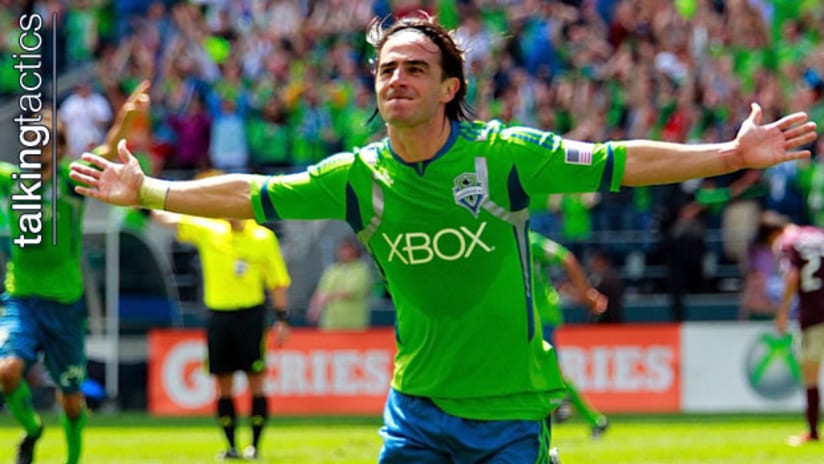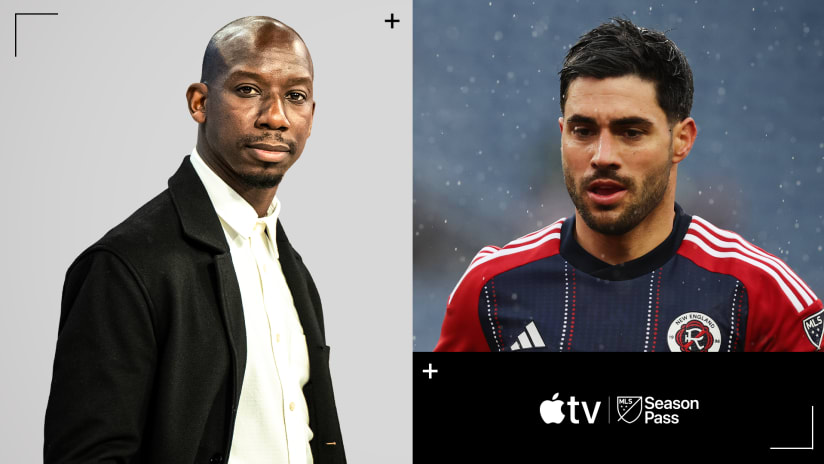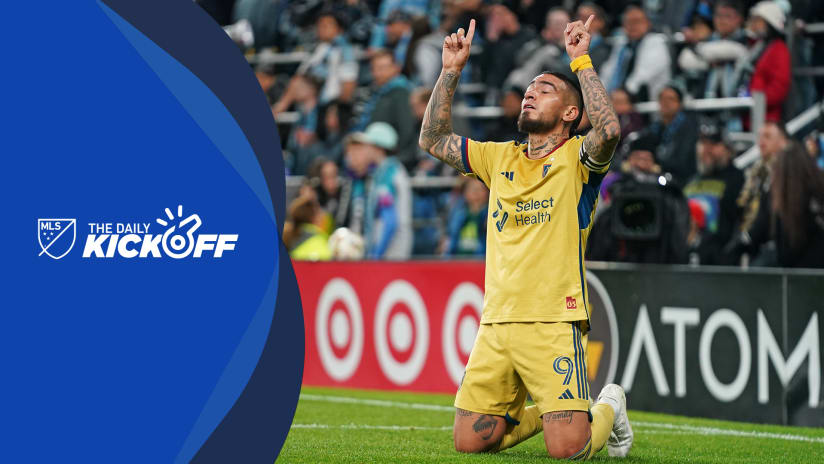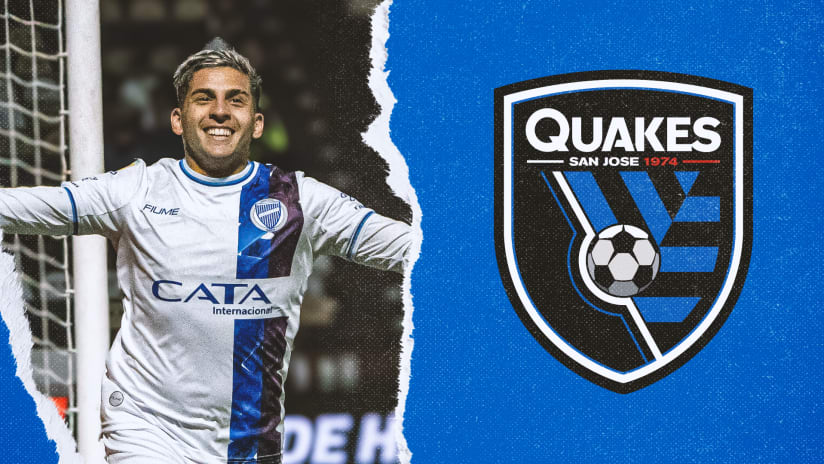In a day where tactics are determined through advanced scouting, through diligent video study and digital tagging of individual and team tendencies, it’s nice to see some good, old-fashioned ground-level improvisation at work.
Sometimes all the high-tech edge of modern soccer can be trumped by adaption to conditions or circumstances of the day — also known as “figuring it out.”
We saw it last Saturday in Seattle, where one team adapted to field conditions far better than another.
The background: Colorado met Seattle at CenturyLink Field, where matches usually happen on artificial turf. But, as mighty Manchester United visit on Wednesday, club officials have covered the plastic pitch with sod. It was already in place Saturday, available for the Rapids’ trip to the Pacific Northwest.
As we know, these temporary grass surfaces tend to be functional but highly imperfect. They are typically slow and missing some bounce (literally). In this case, rain had exacerbated the tendencies.
Whether it came from the bench or if players figured things out on the fly, the home team was faster to embrace the US Marine Corps motto: improvise, adapt and overcome. That’s part of all sports, after all, to meet the conditions of the day. Tactically, here’s how it went:
HIGHLIGHTS: Seattle win shootout vs. Rapids
alt="Get Microsoft Silverlight" border="0" src="http://go.microsoft.com/fwlink/?LinkId=108181" ckesavedsrc="http://go.microsoft.com/fwlink/?LinkId=108181" ckesavedsrc="http://go.microsoft.com/fwlink/?LinkId=108181" ckesavedsrc="http://go.microsoft.com/fwlink/?LinkId=108181" ckesavedsrc="http://go.microsoft.com/fwlink/?LinkId=108181" ckesavedsrc="http://go.microsoft.com/fwlink/?LinkId=108181" ckesavedsrc="http://go.microsoft.com/fwlink/?LinkId=108181" ckesavedsrc="http://go.microsoft.com/fwlink/?LinkId=108181" ckesavedsrc="http://go.microsoft.com/fwlink/?LinkId=108181" ckesavedsrc="http://go.microsoft.com/fwlink/?LinkId=108181" ckesavedsrc="http://go.microsoft.com/fwlink/?LinkId=108181" />
Seattle’s midfield has achieved harmonious balance lately. Osvaldo Alonso holding, Mauro Rosales on the right, Álvaro Fernández on the left and Erik Friberg playing slightly higher, centrally, are combining well with a variety of short, medium and long passing.
Meanwhile, Fredy Montero is creating underneath striker Roger Levesque, and it has all cooked up beautifully as the Sounders are unbeaten in nine straight.
But if they were zigging before with varied passing through the midfield, spiced with balls targeted into Levesque, they zagged on Saturday afternoon. Far more probing balls were regularly aimed into the corners or played more hastily behind Colorado’s back line.
Why? Because those balls could be played deep but still be counted on to settle quickly. On any other day, most of those efforts before would skip off the fast turf, flying harmlessly into touch or into the penalty area to be collected by grateful goalkeepers.
Not on this day. Seattle determined quickly that those balls dependably would create the very situation defenders deplore, running at top speed toward their own goal to collect or clear balls that had calamity written all over them.
Further, it wasn’t just that the long balls were so useful, it was also what the longer passes helped Seattle avoid. The slow pitch rendered a short passing game difficult to the point of dangerous. To dribble or play the little tiki-taka game through the midfield was to flirt with harmful turnovers.
So one early ball through the middle sat up nicely for Friberg, creating the first inviting Sounders’ chance. Shortly later, Fernández ran onto a similar ball from Alonso and then fought off the challenge to open his team’s scoring.
Time and again from there, diagonal balls from the middle were aimed for Rosales, who was playing slightly wider on the right compared with Fernández on the left. Rosales ran onto one with ample time to serve a great ball to Levesque, who scored Seattle’s second.
Brad Evans later got well behind a perilously high Rapids back line to go one-one-one with Matt Pickens, with only a heavy touch as he approached the penalty preventing a grand chance. No matter, subsequent balls in behind the Colorado defense led to two more goals. All of which takes us to the other half of the equation: the Rapids’ curious choice to continue playing a very high defensive line abetted Seattle’s strategy.
Perhaps it was all about pressuring in midfield to strip opportunities, about hoping to close space before those balls could be played behind the back four — but it backfired terribly. Seattle did a wonderful job of hitting first-time balls over the defense or through the gaps, and there was simply too much to deal with as Rapids defenders continually chased balls while running full speed toward their own goal.
At the other end, Seattle smartly withdrew their back line, maybe even playing further back than usual, recognizing the certain danger of having speedy Colorado striker Omar Cummings running onto the very type of passes being dropped mercilessly into Colorado’s end.
They also understood that by providing more space to pass in and around the midfield, they were effectively providing more chances for the Rapids to bungle possession while navigating that tricky turf.
Sounders manager Sigi Schmid talked afterward about those long balls creating chances. He acknowledged that on artificial turf, “some of those switching balls to Mauro and Álvaro are going to run out of bounds. So as a result, you saw more of a free-flowing game.”
It just flowed a little more to one side. All in all, Colorado did enough on the attack. After all, scoring three goals on the road usually means splitting the points, at least. But Seattle found the better way to cope with conditions and danced happily away with the points.












